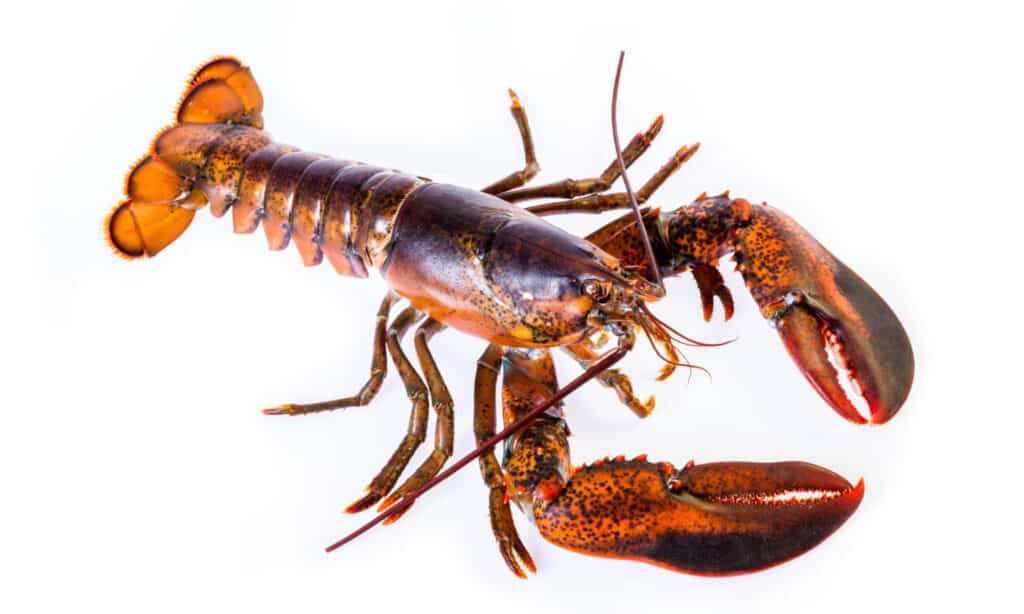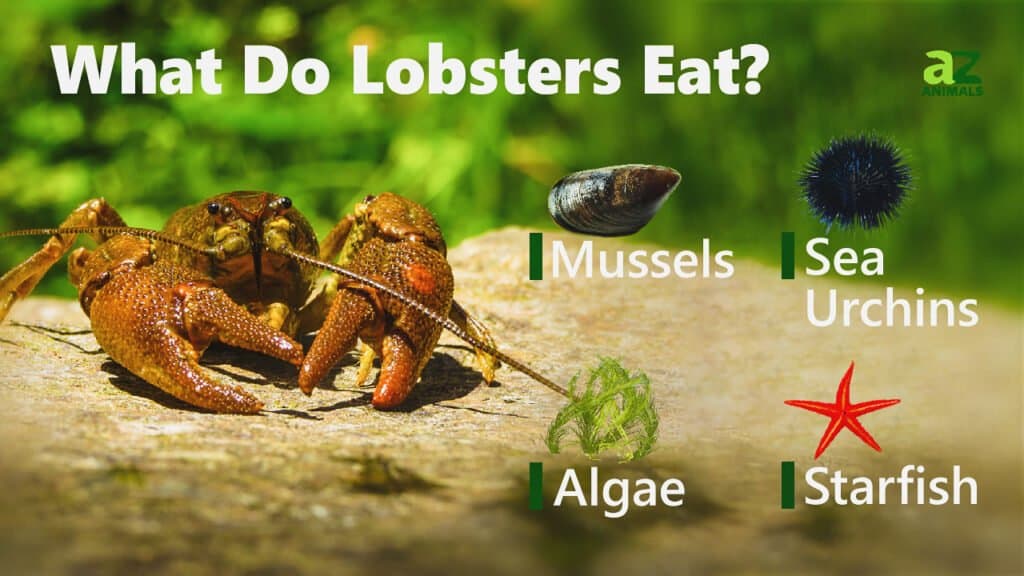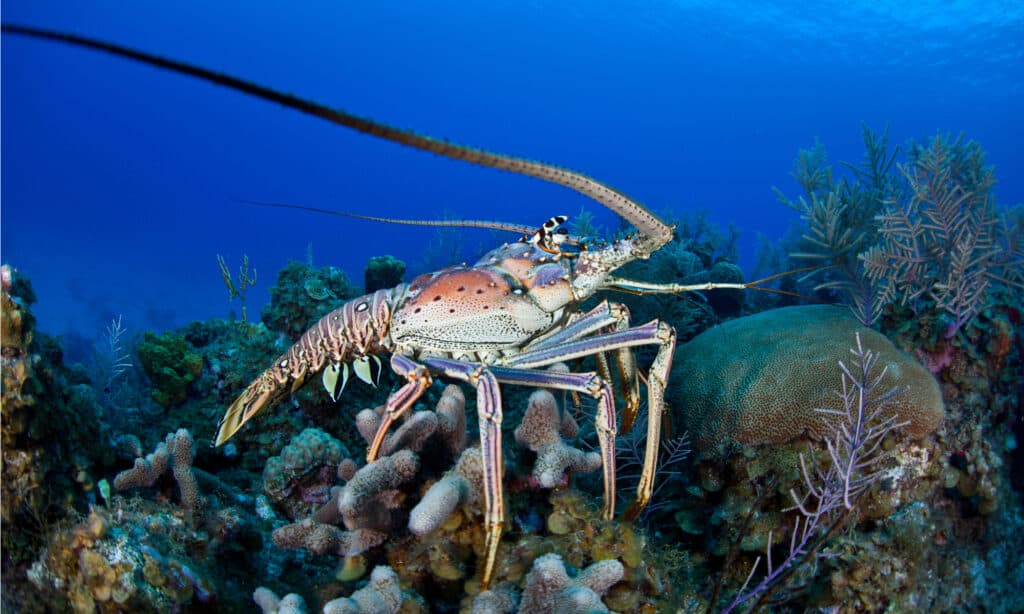Lobsters are considered a delicacy in many countries! Millions of people delight in at least one well-prepared lobster every year, and it’s no wonder, as their meat is exceptional! But what do we really know about these aquatic creatures? What do we know about what’s inside their shell, what they eat, how they digest food, and, finally, their poop? Should we remove a lobster’s poop before cooking it? You’ll find all your answers below!
What is a lobster?

Lobsters are aquatic invertebrates with an exoskeleton.
©LittlePerfectStock/Shutterstock.com
Lobsters are crustaceans that can be found worldwide. The lobster family consists of 30 clawed lobster species and 45 spiny lobster species.
These aquatic animals are invertebrates with an exoskeleton. They have eight walking legs. Their front pincers are also considered legs, so biologically speaking, lobsters have ten legs – they are also called decapods (deca = ten), after all.
A lobster’s body consists of the following:
- The antennules that help the lobster taste the food and detect threats;
- The antennae that have a sensory function;
- The compound eyes;
- The carapace is also called cephalothorax and has the function of protecting internal organs;
- The five pairs of legs;
- The tail, sometimes called the abdomen, contains the digestive tract; it consists of six movable parts, the tail fan, and the pleopods, which are feather-like appendages.
A lobster’s internal organs are:
- The mouth;
- The gills;
- The heart;
- The gonad (which produces eggs or sperm);
- The hepatopancreas (the gastronomically-called tomalley);
- The digestive tract;
- The anus, from where lobster waste comes out.
What do lobsters eat?

Lobsters are omnivorous animals. Here’s what they eat:
Do lobsters poop out of their mouths?
No, lobsters don’t poop out of their mouths. They have an anus at the end of their digestive tract where the excrements come out from.
What’s a unique thing about lobster poop?
As weird as it may sound, lobster poop has been the subject of a major study that revealed something unique about these aquatic animals.
Lobsters feed on jellyfish, as mentioned above. But how do they protect themselves from their venom? This study showed that lobsters aren’t immune to jellyfish venom but still eat it. Scientists weren’t sure how the lobsters survived eating them. So they fed them jellyfish and then collected the poop to analyze it under the microscope. What they found out was incredible!
The jellyfish venom was indeed released and active but was covered by a protective membrane resembling a sheath. This prevented the toxins from reaching the lobster’s organs. Isn’t it impressive?!
How do you get the poop out of a lobster?

The vein in the tail of a lobster is the lobster’s digestive tract which ends with the anus.
©Ethan Daniels/Shutterstock.com
If you’re a fan of lobster meat, then you must also be excited to cook it at home! But how should you clean the lobster and get the poop out? Some fish traders remove the tail before selling the lobsters, while some prefer to leave it intact. If you’ve bought one with a tail, here’s what you should do:
- First of all, wash the exterior of the tail with cold water. You can brush the shell, but do not touch the exposed meat! Putting the tail in water will make the lobster’s meat watery, as it will absorb the liquid.
- If you don’t want to eat the tomalley, you can brush it away with your fingers.
- Then, you’ll need to remove the vein in the tail. This vein is, in fact, the lobster’s digestive tract that ends with the anus. If you don’t like its taste, you’ll need to remove it. The vein is translucent white and black, so it is easily recognizable on the exposed portion of the tail. You must grab the vein from the tail end and pull it until it comes out. Another way to remove the vein is by cutting the tail through its center. This way, the vein will be visible, and you’ll be able to get it out. If you decide to cut the tail, it’s advisable to oil the meat. This will help avoid drying it out while cooking.
Is lobster tomalley poop?
Tomalley is a green hepatopancreas, sometimes called a digestive gland or the midgut gland. It is not poop. It is an organ of the lobster’s digestive tract—the tomalley functions as liver and pancreas altogether.
Tomalley is a green substance in cooked lobster that some people find delicious.
Can you eat tomalley?
Yes, tomalley is edible. It is advisable to be consumed in moderate portions, however, as it may contain PCBs – polychlorinated biphenyls, which are carcinogenic chemical compounds. When consumed in high quantities, it can negatively affect the human body. Tomalley can also contain paralytic shellfish toxins that may cause paralytic shellfish poisoning.
For example, in 2008, the Food and Drug Administration (FDA) stated that the lobsters caught in New England waters registered high levels of toxins, so they advised people to avoid eating the lobster’s tomalley.
Lobster parts you should not eat

Lobster claws and shells should not be consumed.
©davemhuntphotography/Shutterstock.com
We’ve already discussed the “debatable” tomalley and the vein, but are there other lobster parts you should not eat?
First, it’s highly recommended not to eat raw lobsters, as they contain numerous bacteria that can cause severe illnesses. If your lobster is well-prepared, here are the parts you should think twice about before eating them:
- The roe – the unfertilized eggs of a female lobster. While this is a delicacy in some countries, the roe may have an unpleasant taste, and many people may find it disgusting. These eggs are red.
- The stomach – can contain bones and shell particles that will make the lobster tasting experience worse; moreover, the stomach contains digestive juices that can change the meat’s flavor.
- The claws and shell – while eating the roe and the stomach depends on your preferences, the shell and the claws (as in their coverings) cannot and should not be eaten. They are so hard that swallowing them is impossible; if someone somehow manages to do that, it will be painful and may damage the esophagus.
The photo featured at the top of this post is © davemhuntphotography/Shutterstock.com
Thank you for reading! Have some feedback for us? Contact the AZ Animals editorial team.






